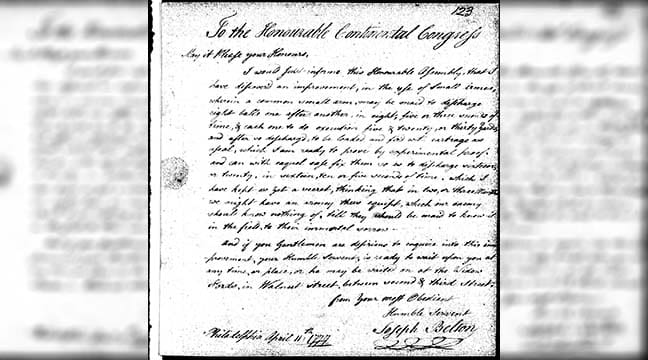Gun control advocates love to claim that the Founding Fathers couldn’t possibly have conceived of repeating rifles when they drafted the Second Amendment to the Bill of Rights. The history of Joseph Belton, an inventor and gunsmith from Philadelphia, and his correspondence with the Continental Congress proves otherwise.
Belton claimed to have devised a new form of repeating flintlock musket that was capable of firing as many as sixteen consecutive shots in as little as twenty seconds. After the gun had fired its consecutive loads, it could then be reloaded individually like all other traditional weapons of that time.
Belton wrote to Congress about his new invention on April 11, 1777, letting them know he could be available to demonstrate it to them at any time.
Intrigued by Belton’s claim, Congress ordered 100 examples of his “new improved gun.” They authorized him to oversee the construction of new guns, or alteration of existing guns, so that they were capable of discharging eight rounds with one loading and that he “receive a reasonable compensation for his trouble, and be allowed all just and necessary expences [sic].”
On May 7, 1777, Belton replied to Congress with his terms regarding what he felt to be reasonable compensation. He wanted to arm 100 men with his invention, demonstrate the capabilities to top military officers, and see how many men the officers felt his 100 men were equivalent to.
For example, 100 specially-armed men were the equivalent of 200 regularly-armed men, or more. For his ability to double the manpower, he felt that he was entitled to £1,000 from each state that he armed 100 of their men.
Belton justified the price by claiming that a state could not raise, equip, and clothe 100 men for £1,000, making his 100 men armed as though they were 200 men a bargain. For reference, £1,000 in 1777 is the equivalent of £116,500 in 2016. If all 13 states outfitted 100 men, Belton would receive £13,000 – or a cool £1.5 million today.
Belton argued that arming 3,000 men or more with his invention created advantages beyond description on the battlefield and that, as such, his compensation was “vastly reasonable” and that if the Congress refused his terms, he wouldn’t do it.
(For those doing the math, 3,000 men armed with Belton’s repeater would mean that he’d collect almost £3.5 million if adjusted to current dollars.)
Belton must have realized immediately that his demands were more than outlandish because the next day, on May 8, he wrote a letter to John Hancock lowering his fee to £500 for doubling, £1,500 for tripling, £2,000 for quadrupling, and so forth.
On May 15, Congress read Belton’s letter to the body. They quickly dismissed it because of his “extraordinary allowance.” (No one saw that coming, right?) Congress considered the matter dropped and didn’t bother to reply to Belton, likely assuming he would take their lack of reply as a refusal.
Having heard nothing from Congress, Belton wrote them again on June 14. This time, he claimed he could make the shots accurately out to 100 yards and then, worrying that wasn’t impressive enough, said he could make the shots out to 200 yards and would be available to demonstrate this to the body on the State House Yard.
Again, he heard nothing for almost a month.
Still undeterred, Belton wrote Congress again on July 10. This time, he tried to rile members of the body by claiming that Great Britain regularly pays £500 for such services.
He also enclosed a letter signed by General Horatio Gates, Major General Benedict Arnold (written before he became a turncoat), well-known scientist David Rittenhouse, and others, all claiming that his invention would be of “great Service” and that Belton is entitled to “a hansome [sic] reward from the Publick [sic].”
Having received the letter immediately, Congress resolved that same day to refer Belton’s petition to the Board of War, made up of five delegates. Among these five delegates were future second President of the United States, John Adams, and Benjamin Harrison V, father and great-grandfather of the 9th and 23rd Presidents.
Nine days later on July 19, Congress heard from the Board of War. They dismissed Belton’s petition altogether. At this point, he must have finally gotten the hint that Congress wasn’t going to authorize such exorbitant payments for his services because the historic record turns up no more correspondence between Belton and Congress.
Despite the fact that Joseph Belton failed to convince the Continental Congress to outfit colonial soldiers with his repeating rifle, it’s still a very important story. Belton invented his repeating gun in 1777. The Bill of Rights wasn’t ratified until 1791.
I’m no math whiz, but even I know that means our Founding Fathers not only knew about repeating rifles 14 years before the creation of the Second Amendment, but that they thought highly enough of the design to pursue further development and implementation of such technology.
So the next time someone claims the Second Amendment was never designed to protect the right to own a repeating rifle, or that it was only meant to apply to flintlock muskets, you can tell them the story of Joseph Belton and his repeating flintlock musket.
Logan Metesh is a firearms historian and consultant who runs High Caliber History LLC. Click here for a free 3-page download with tips about caring for your antique and collectible firearms.
